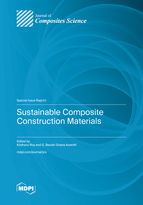Sustainable Composite Construction Materials
A special issue of Journal of Composites Science (ISSN 2504-477X). This special issue belongs to the section "Composites Applications".
Deadline for manuscript submissions: closed (31 December 2022) | Viewed by 28517
Special Issue Editors
Interests: cold-formed steel structures; application of artificial intelligence and machine learning for the structural prediction of steel structures; fire engineering; modular construction; sustainability and life cycle analysis of structures
Special Issues, Collections and Topics in MDPI journals
Interests: cold-formed steel structures; finite element analysis; steel–concrete composite structures; machine learning techniques; construction management; construction materials; sustainable construction
Special Issues, Collections and Topics in MDPI journals
Special Issue Information
Dear Colleagues,
Often, a project's sustainability is centred on building services and energy, but we need to have a comprehensive view of how we integrate deeper sustainability. Traditionally, we have neglected embodied carbon generated during building construction, which has led to significant carbon emissions over the last few decades, causing global warming and other related problems. The aim of this Special Issue is to collect the results of research and practice experiences in sustainable building structures, made from steel, concrete, timber, and other composite materials. Dr Roy and Dr Ananthi warmly invite authors to submit their papers for potential inclusion in this Special Issue of “Sustainable construction using steel, concrete, timber, and other composite materials”, in the journal of Journal of Composites Science.
Dr. Krishanu Roy
Dr. G. Beulah Gnana Ananthi
Guest Editors
Manuscript Submission Information
Manuscripts should be submitted online at www.mdpi.com by registering and logging in to this website. Once you are registered, click here to go to the submission form. Manuscripts can be submitted until the deadline. All submissions that pass pre-check are peer-reviewed. Accepted papers will be published continuously in the journal (as soon as accepted) and will be listed together on the special issue website. Research articles, review articles as well as short communications are invited. For planned papers, a title and short abstract (about 100 words) can be sent to the Editorial Office for announcement on this website.
Submitted manuscripts should not have been published previously, nor be under consideration for publication elsewhere (except conference proceedings papers). All manuscripts are thoroughly refereed through a single-blind peer-review process. A guide for authors and other relevant information for submission of manuscripts is available on the Instructions for Authors page. Journal of Composites Science is an international peer-reviewed open access monthly journal published by MDPI.
Please visit the Instructions for Authors page before submitting a manuscript. The Article Processing Charge (APC) for publication in this open access journal is 1800 CHF (Swiss Francs). Submitted papers should be well formatted and use good English. Authors may use MDPI's English editing service prior to publication or during author revisions.
Keywords
- Cold-formed steel composite structures
- Analytical modelling for optimizing
- Energy efficient buildings
- Modular buildings
- Prefabricated building systems
- Hybrid construction
- Pre-Engineered buildings
- Managing the available facility
- Composite cold-formed steel flooring systems using timber , concrete, light weight concrete
- Flexural behaviour of composite beams made of cold-formed steel sections
- Energy efficiency of hybrid cold formed steel sections
- Light weight housing using cold formed composite sections
- Efficiency of CFS composite connectors in floor system
- Structural Performance of CFS composite structures under dynamic loadings
- Quick construction techniques using CFS composite members
- Behaviour of connectors between cfs composite floors or composite members
- Alternative approach to pre-engineered CFS composite frames
- Behaviour of composite columns of CFS members with different material infill







